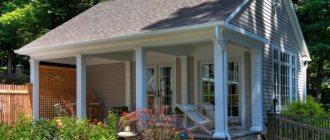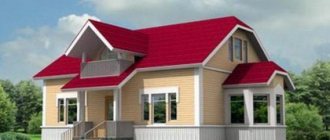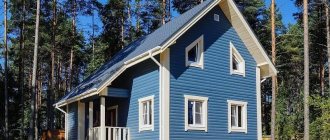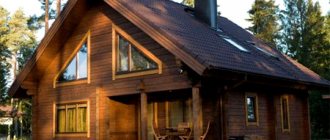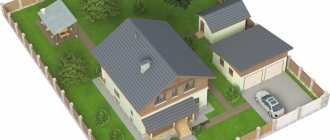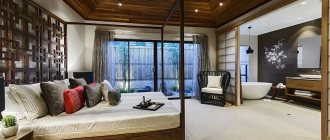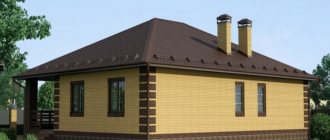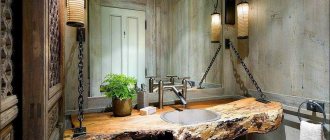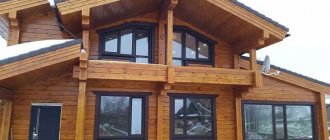Building a house is a very important moment, because in addition to choosing a site, deciding what material to build the house from, calculating the budget, you also need to carefully consider the layout of the future home.
The comfort and functionality of the house, as well as further costs of its operation, depend on the correctness of design.
Let's draw - we'll live!
Naturally, before starting construction, it is important to draw in detail all the nuances - the area of the rooms, windows and interior partitions, taking into account the design safety features.
An overview of ready-made options for private houses can always be found on the portal dachnichek.ru.
Ready-made software solutions will help you, with which you can either adjust the finished layout or create your own project from scratch.
3D visualization programs allow you not only to schematically depict the plan of a future building, but also to create a photo design of the interior of the house and landscape design of the site.
Types of roof spaces
There are several types that characterize the space of an attic house. They depend on the type of roof chosen and the materials from which the building was constructed:
- single-level - this type combines gable and sloping roofs, complemented by external consoles;
- two-level - the result of using different supports.
When working with a project, it is important to correctly calculate the loads not only for construction, but also for further residence.
What is important to consider when designing
A house with a square layout, especially a small one, is one of the most popular on many online construction resources. Search engines offer thousands of photos of various 8x8 m2 house designs and sometimes it’s difficult to make a choice.
We recommend that you first decide on the key nuances that are important to you.
Does your family gather around the dining table and do you need a spacious kitchen-living room, in which room do you need more daylight, do you want a dressing room, is a shared or separate bathroom preferable?
These and other details will allow you to significantly narrow the range of proposed layouts for 8 by 8 houses.
Construction
A house made of 8 8 m timber begins to be built with the construction of a foundation. Considering that wood is less heavy than brick or concrete, it is not made as capital. The types of foundation for construction are:
- tape;
- columnar.
Based on its depth, it is divided into shallow (50-70 cm) and deep (over 70 cm).
For the construction of houses made of timber, a shallow strip foundation made of concrete is usually chosen. After it has dried, a layer of waterproofing should be applied before laying the first row. It will protect the wood from moisture that will condense on the concrete surface.
The lower crown should be wider than the other beams. This is necessary because it will bear the weight of the wall and part of the roof. Subsequent crowns are placed either on dowels (pegs) or in grooves (if the timber is profiled). Each new layer is laid with a compactor.
The house plan must include window and door openings, which are made immediately as the rows are erected.
To prevent the wall from losing its shape during construction, special frames are used in the shape of the opening (casing), around which beams are attached. There should be a small gap at the top of the casing, which compensates for the displacement when the house shrinks.
The floors are laid on joists built into the first row of walls. First, a subfloor is laid, a layer of moisture insulation is placed on top, and insulation is insulated. The finishing floor is placed on top.
Since the layout of the house provides for several rooms, the internal partitions are also made as the timber walls are erected.
After the walls are erected, it’s time to lay the ceiling and build the roof. To do this, thick beams are used, on which the rough ceiling, lathing are attached, insulation and waterproofing are placed. Then the rafters are installed. Transverse bars are placed on them, the distance between which should not exceed 60 cm.
A sheathing for insulation is attached to the top, and beams are placed on it for installing a roof made of slate or metal tiles. If the house plan provides for a soft roof, an OSB board is placed on the beams.
It should be remembered that the roof must protrude beyond the wall by at least 60 cm.
This will protect the walls of the house from rain and extend the life of the house made of timber.
Brick house
A brick house is still the most popular option, because... no one doubts its durability.
Advantages:
- High wear resistance
- High noise insulation
- Good thermal insulation
- Wide possibilities for implementing projects of any complexity.
- Difficulty of installation
- Heavy weight
- The need for a strong foundation
- The need for thermal insulation material.
Frame house
Frame houses are the fastest and most economical way to build a house.
Advantages:
- Does not require special knowledge and construction skills
- Construction speed
- Low cost
- Possibility of installing communications inside the house
- Aesthetic appeal
- A small foundation is enough.
- Not environmentally friendly
- Favorable environment for rodents
- Fragility
- The greenhouse effect and the need for supply and exhaust ventilation.
House made of ceramic blocks
Ceramic blocks have appeared in modern homes not so long ago, but have already gained some popularity.
Advantages:
- Fire safety
- High thermal insulation properties
- No need for vertical seams due to special sealed joints
- Easily absorbs moisture
- Quite low resistance to shock loads
- The need to use special tools during installation
- Relatively high cost
- The need for strict adherence to technology
- The need to use special dowels and anchors.
Advantages and disadvantages
Due to the growing popularity of these buildings, construction companies are increasingly paying attention to them, as such buildings have many advantages. Design advantages:
- construction and installation work make it possible to save money;
- with proper use of the space, its area can increase;
- thanks to the roof, heat loss is reduced;
- communication systems can be easily installed from the ground floor;
- despite the continuation of construction, it is allowed to use the first floor;
- in the attic you can organize non-residential premises;
- During the arrangement, imagination and creativity are encouraged.
In addition to the advantages, when building a house there is also the possibility of encountering disadvantages:
- the main disadvantage is that if the technology is not followed during construction, there may be serious consequences. Most often, this is an increase in heat losses, due to which the room freezes and condensation forms on the walls;
- the cost of dormer windows is almost 2 times higher than the cost of conventional window structures. In addition, this is influenced by the specificity of window installation;
- Natural lighting plays an important role in comfortable living, it does not allow microbes to multiply and has a positive effect on vision, but it may be disrupted due to weather conditions, so it is necessary to create conditions for free access to sunlight.
What does the layout of a 64 m2 house include?
Almost all projects of a one-story 8x8 house include 2 small bedrooms (10-12 m2), a kitchen and a living room (sometimes combined) - with a total area of up to 24 m2 and a bathroom.
Sometimes one bedroom is enough, then you can expand the square footage of the rooms, or add additional rooms - storage rooms, dressing rooms, etc.
House 140 sq. m.: finished projects, tips on choosing the design and decoration of a home (125 photos)- House 9 by 11: ready-made projects and optimal solutions for placing rooms. 130 photos of interior and exterior design ideas
- Blue curtains: review of popular shades, combination options, new designs
The area of the house is approximately equal to a standard three-room apartment, so a family of more than 3-4 people will be extremely cramped in an apartment of this size.
If the site of the house does not allow you to take up more space, or you just want to leave space for an orchard or play area, terrace or swimming pool, then you can always increase the area of the house not in width but upward.
Economical option
Let's consider the layout of the house in the photo with one floor. This building will have two bedrooms: 12 and 18 square meters. m. The smaller room is designed for parents, and the larger one, with two windows, is for older children. Such a modest layout will provide a corner for each student, sleeping places and small closets for linen and student supplies. The hall may be slightly larger than the size of a large bedroom, approximately 20 sq.m. The remaining 14 sq.m should be distributed between the kitchen, bathroom and corridor. Of course, the resulting rooms will not be very large, a little larger than in a 2-room apartment. The standard placement option is most often used. In front of the front door there is a small corridor from which there is an entrance to a small combined bathroom. Interior doors lead to the kitchen, living room, and bedrooms. The placement of bedrooms is different, but the best option is observed when the bedrooms are not placed next to each other. The sequence and specific placement of rooms is determined based on the size and configuration of the rooms. Usually the kitchen is located closer to the entrance, and the hall occupies the farthest room. This placement is not standard. Often one of the grown-up children chooses the living room as his personal room with a sleeping place.
Double the area
The second floor will allow you to expand the space without borrowing additional space on the site; sometimes it is replaced by a residential attic.
Standard designs for a two-story house 8 by 8 square meters, as a rule, propose placing common areas on the ground floor - a kitchen, living room, bathroom and other non-residential premises.
On the top floor there are all the bedrooms and an additional bathroom. In this case, you can place 3 bedrooms with an area of about 12-16 m2.
Often such house designs include a dressing room, which can be placed either on the second floor or a place for it can be determined in part of the interfloor staircase.
The space of the house allows you to additionally place a balcony on the second floor; the area under it is usually designated as a terrace.
How to reduce construction costs
An attic instead of a full second floor will allow you to significantly reduce both the financial and time costs of building and finishing a house with an area of 8 by 8 m2.
This option is the most optimal in terms of the ratio of construction costs and usable area of the finished building.
The attic can be used to accommodate bedrooms and children's rooms; it is important to take into account the different heights of the ceilings.
In case of insufficient lighting, separate sections with windows are added, or window openings are placed directly on the roof.
It is also difficult to select furniture for the attic floor - in this case, either use low furniture (chests of drawers instead of cabinets), or install tall furniture on the side of the highest wall, or create an individual design that follows the extreme lines of the ceiling.
Recommendations for choosing the right layout
When determining a planning solution for a residential building, it is recommended to take into account the following nuances:
- functions of living space (permanent residence, country house);
- planned budget;
- number of residents;
- features of organizing leisure time for residents;
- ready-made planning solution or original design;
- dimensions of the building site.
It is optimal to use a ready-made construction plan and, if necessary, change or supplement it. The method allows you to maintain an effective technological solution in the building and give the project originality.
The area of the building site is estimated. For owners of small plots of land, it is recommended to build buildings with an attic. The addition of a terrace or veranda will subsequently help to increase the living space. Projects of houses with 2 floors require large financial costs; this option is suitable for a large family.
Decorative elements (bay windows, columns) must be introduced into the project carefully, because... The total area of the house is compact. When drawing up a drawing, it is recommended not to use narrow corridors, it is optimal to make several rooms pass-through or organize several entrances to the building to prevent visual overload.
Photos of houses 8 by 8
Help the project, share with friends

0
